Campbell Town DHS 10 Science
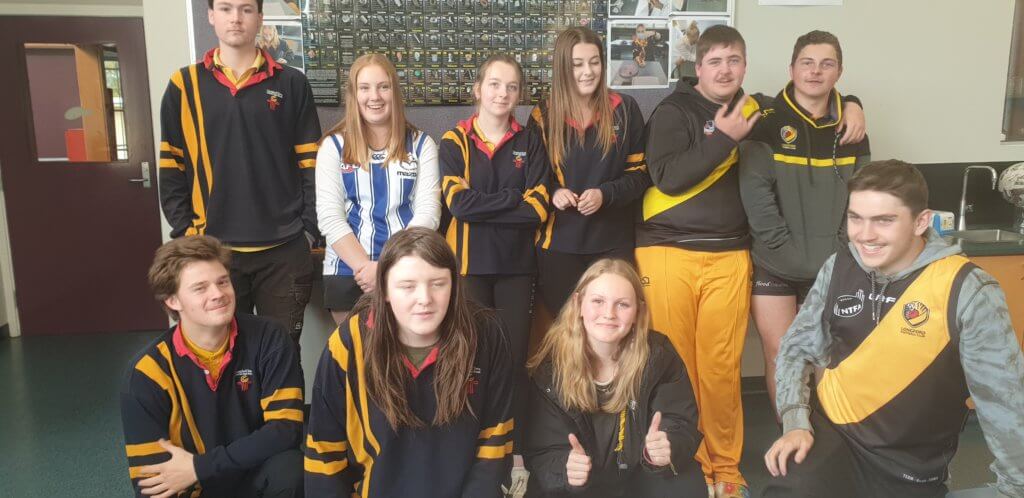
Hey Campbell Town Grade 10s!
Thank you for your questions about climate change. You asked some really interesting questions about taking action, pollution, extreme weather and buildings.
You'll find answers to your questions from our climate experts below - have a read and watch their answers.
You can also have a look at what other classes across Tasmania asked this year, as well as our climate change toolkit.
Our Questions
The how and the why of climate change are very tightly linked, so tightly linked people as far back as 1896 had figured out the basics of how it works. Earth’s atmosphere keeps the world warm by trapping heat. It does this in a way similar to the way a greenhouse works (thus the name “greenhouse effect”). Sunlight (and warmth) can come through the atmosphere in the day time and warms up the land and sea areas. At night cooling occurs, with the heat escaping into the atmosphere, some of that leaks out into space again, but not all because the atmosphere traps some of the heat. The key bit of the atmosphere that traps the heat are the greenhouse gases.
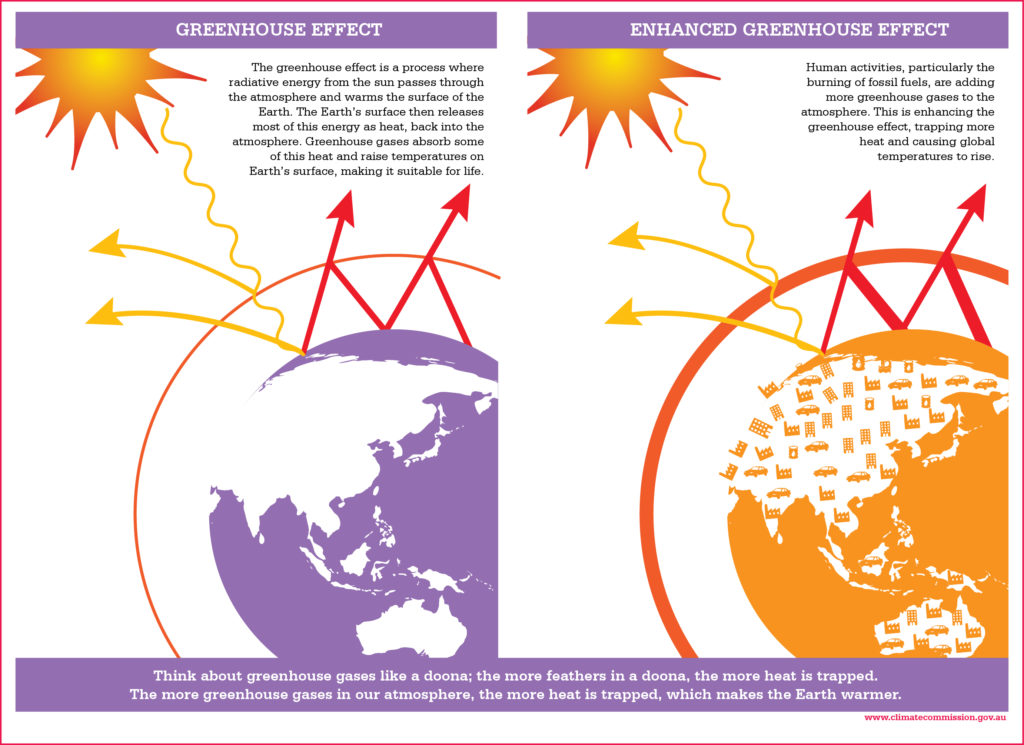
Natural greenhouse gases are water vapor, carbon dioxide, methane, ozone and nitrous oxide. These chemicals are an important part of the world’s natural cycles. They cycle between the atmosphere, the ocean, soils and rocks. Human activities have changed those cycles, meaning more greenhouse gases have entered the atmosphere, trapping more heat and leading to global warming and climate change.
Many human activities influence climate relevant cycles, but two of the most important are to do with carbon dioxide and methane. Fossil fuels contain carbon dioxide locked up millions of years ago, by bringing it to the surface and burning the fossil fuels human activity short circuits natural weathering and other cycles, creating one of the major sources of the excess carbon dioxide that is creating climate change.
Agriculture is also a major contributor to climate change, producing about a quarter of all current greenhouse gas emissions. These emissions come from the fuels used by farmers, but also because of emissions from rice paddies and livestock, which produce methane. A particularly powerful greenhouse gas, over a 20-year period methane is 80 times more potent at warming than carbon dioxide. On top of this, the removal of native vegetation, like forests, to create space for agriculture reduces the amount of carbon drawn out of the atmosphere and stored in trunks and roots as trees grow (known as sequestration).
As you can see there are many interconnected ways that human activities are influencing the biogeochemical cycles of Earth and thereby contributing to climate change.
Good sources of climate information are https://climate.nasa.gov/ and the new IPCC climate atlas https://interactive-atlas.ipcc.ch/
Two good Australian information sources are the CSIRO https://www.csiro.au/en/research/environmental-impacts/climate-change/Climate-change-QA and the Academy of Science https://www.science.org.au/education/immunisation-climate-change-genetic-modification/science-climate-change
You might also like to play with the simple climate model at en-Roads, explore options for reducing climate change https://en-roads.climateinteractive.org/scenario.html?v=21.10.0
This is an excellent question, and one of the questions most students want an answer to. You can be someone who takes climate action!
Each of us can act individually (on our own) and collectively (together with others) to act on climate. We know, from scientific evidence, that climate change cannot be stopped and is happening already – but it can be reduced and slowed down. People today and into the future (including you) can make changes and decisions that will greatly reduce climate change and its impacts.
Some of these decisions are happening on a systemic scale - they the really big changes we need to reduce emissions from industries and electricity generation.
For example, world leaders are meeting together at COP26 (which is the UN Climate Change Conference of the Parties) to discuss pathways to do this – in particular, to ensure that global temperature rises do not exceed 1.5 degrees, and how we can adapt to climate change impacts into the future. If we can manage to greatly reduce global greenhouse gas emissions (such as carbon dioxide) we can limit climate change.
You might wonder how young people can influence big changes like this? By using your voices! Young people are involved in many groups and movements such as the School Strikes for Climate that have already made a difference to the way world leaders think about climate action.
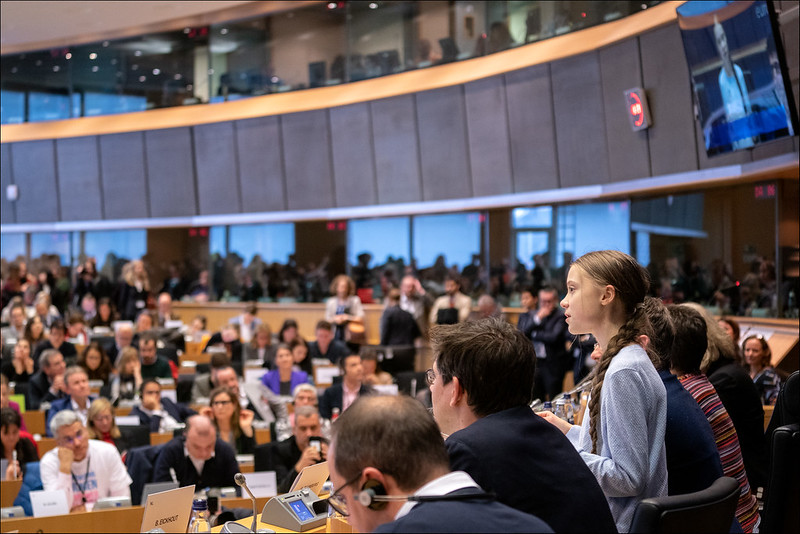
At a smaller scale, all of us can do something to make positive changes and have an impact on tackling climate change. Some people can do more and less than others, and that is OK - it’s great actually because lots of small changes can lead to big impact. In everyday life, there’s lot that you might be able to do, for example:
- You can aim to take the bus or walk, or ride your bike to school more.
- You could eat more vegetables, and eat meat less often (maybe even encourage your family and friends to have ‘meat free Mondays’?!). Plant-based foods generally produce fewer greenhouse gas emissions and they also require less energy, land, and water usage.
- You can speak up! Tell your friends and family about climate change and the small changes each of us can do to make a difference - remembering that we all have different abilities to make these changes, big and small.
There are a lot more ideas you can check out on our 'What can I do?' page.
I received quite a few questions asking about the most effective way to stop climate change, and how kids can be part of the solution. As you probably know, the key thing that we need to do to help stop climate change is to stop emitting greenhouse gases – particularly carbon dioxide and methane. There are things we can all do to help with this, like driving less, using renewable energy, or tyring to eat local produce that doesn’t have to be transported to Tasmania from far away. But for the really big changes to greenhouse gas emissions that are required to help stop climate change we need our governments to implement policy change. The more we all call for these changes – as a community – the stronger our message to politicians will be.
Another thing we will need to do to help stop climate change is to actively remove carbon dioxide from the atmosphere. There are lots of ways to do this, but some of the simplest and most effective are those that harness the power of nature. Planting more trees, leaving coastal and marine habitats like mangrove forests, seagrass meadows and kelp forests intact. If you’re interested in engineering then there are also some very cool technologies emerging that will help us to pump carbon dioxide out of the atmosphere and back under the ground.
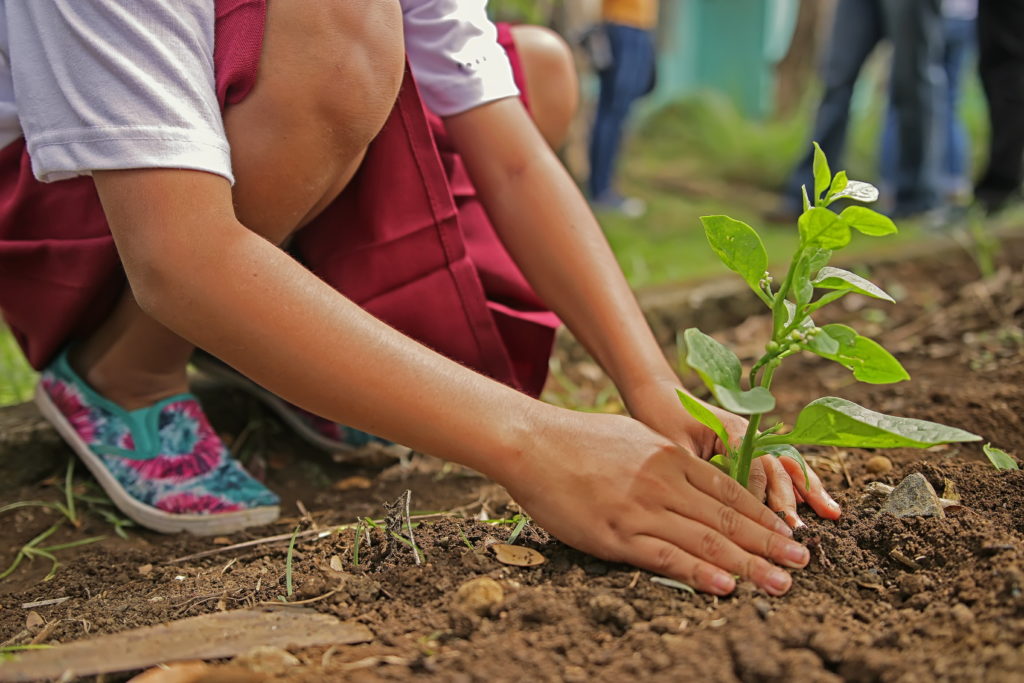
The future of Tasmania and of our planet belongs to kids of today, not to grown ups. Kids ask great questions and they are fantastic at thinking up new ways to solve problems. I think that one of the most important things that kids can do is to keep asking questions and to keep learning to be problem solvers. Keep being curious and caring about climate change!
This is such a great question! Taking climate action is really important for stopping or reducing the climate change impacts that we might face. The more people who take action, the more we can collectively curb these impacts.
To understand how to get more people to take action, we need to think of why they might not be taking action already. One reason might be that people don’t know how to take action or where to find information to learn about taking action. In this case, we know that climate conversations are really helpful. Talking to your friends, teachers, neighbours, parents, and other family members about what climate change is, what it means for the world, and what each of us can do to take action, can be a catalyst for people to make changes they might not have done otherwise. In fact, some recent research shows that children build climate change concern among their parents and are key to encouraging parents to take action. You can have your own climate conversations with your parents or other people you know, telling them why climate change is such a big issue and what they, you, and we all can do to take action and make a difference. Check out the Curious Climate Schools website for lots of suggestions on small to bigger ways we can all take climate action.
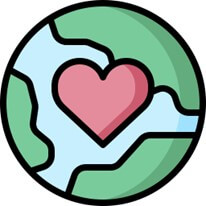
Another reason that people might not already be taking action, is that they are overwhelmed by the climate emergency. They might be sad or angry about climate change and not think that their actions can make a difference. But these individual actions can and do make a difference. We can ask people: Does climate change make you angry, scared, worried? And let them articulate their feelings. We can tell them that this is okay, we all have feelings about climate change and it’s useful to talk about them with our classmates, friends, and families. Talking about climate change can help us all to work together to imagine and create more ways to address climate problems.
For example, to reduce greenhouse gas emissions we can think of ways we can act
- individually: such as recycling or reducing our food waste
- collectively: such as using our voices in climate strikes, or demanding that classrooms and schools make changes too,
- at systematic levels (think big scale): by talking to local politicians about what they are and can be doing to make climate action happen at local to State levels, or by encouraging parents and adults to vote for parties who take climate action into real consideration.
Taking action can help people realise that there is something they can do to make a difference and can help with their feelings of overwhelm and climate worry or anger. Keep talking about climate change to those around you, every conversation can make a difference and encourage people to take actions, big and small 😊
When you walk down a supermarket isle you will notice many items are packaged in single-use plastics. This is because plastic is cheap, lightweight, and durable (i.e. difficult to break) when compared to other packaging materials such as glass (which is heavy and can break easily) or paper (which can fall apart when wet). Supermarkets are a “for-profit” business which means they like to make money and will make decisions that increase the amount of money they make. So, supermarkets are stocking their shelves with products wrapped in plastic because it can make them more money. Remember, plastic is cheap to make, it’s hard to break so products wrapped in plastic are less likely to break and spill their contents all over the supermarket floor, and plastic is lightweight, so products wrapped in plastic are cheaper to transport around the world because they wight less. Supermarkets have also found that they can sell more products when they are wrapped in plastic. This is because some consumers feel items wrapped in plastic are more hygienic than the same item unwrapped and it is more convenient for consumers (i.e. it saves them more time) to grab pre-packed/pre-bagged items than having to select from a pile of loose items. For example, it’s much easier and faster to grab a bag of 8 potatoes or 8 apples, than having to individually select the 8 potatoes yourself and put them into a bag .
Three ways we can support supermarkets to reduce the amount of single-use plastic on their shelves are:
- Don’t buy pre-packed/bagged items and bring your own bags to the supermarket. If we take that bit of extra time to select our own potatoes or apples from the pile rather than grabbing the pre-bagged option, then we are creating consumer demand for supermarkets to stock more apples and potatoes that are not wrapped in single-use plastic. If every consumer made this choice, then supermarkets might stop stocking their shelves with the pre-bagged option.
- Support supermarkets and supermarket products that are wrapped in plastic-alternative or non-plastic packaging. Scientists are developing plastic-alternative materials from plant and seaweed extracts. These alternatives are lightweight and durable like plastic; however, these alternatives are less harmful to our environment. Plastic-alternative materials are becoming increasingly more popular to use in packaging. Next time you are at the supermarket see if you can find any products packaged in plastic-alternative or non-plastic materials. If consumers buy more of these products, then it tells supermarkets to stock more items packaged in these materials.
- Write to your local member in Local, State and Federal Government and ask them to put in a law that requires supermarkets to stock items that are not packaged in single-use plastics. Recently, the Hobart City Council passed a law which banned restaurants and take-away shops from selling their items in single-use plastic packaging. Perhaps this law could be extended to supermarkets as well? Maybe after reading this, you’ve thought of a better way supermarkets can reduce single-use plastics. I encourage you to write it in a letter to your local member or local newspaper. Who knows, maybe your idea and letter will be the start of another solution to win the war on waste! Check out these school students who started their own campaigns that have changed the way we use single-use plastics. No More Straw Campaign by Molly, Bye Bye Plastic Bags a youth driven campaign in Indonesia.

Historically, Australia hasn’t been very good at recycling with only around 11% of what we throw away being recycled into new products and large volumes of our “hard to recycle” materials being sent to our neighbouring countries, such as China, Indonesia, and Malaysia.
However, in 2018, China who received the vast majority of exported recyclable waste from countries such as, Australia, United States of America, and the United Kingdom, said “no more” and banned any country from exporting their waste to China. This ban was known as the National Sword Policy.
China’s new policy was a big wake up call for Australia and forced Australia to rethink and take responsibility for the ways we produce, use and discard products. In 2019, the Australia Federal Government announced a commitment and released a plan to manage and recycle all paper, plastic, rubber tires and glass materials within Australia. This means that every glass jar, plastic bottle, and paper cup you place in your recycling bin, as well as the old tires that get replaced on your parents’ car, will be recycled within Australia, and turned into new products. By 2030, Australia aims to recover and recycling 80% of all waste that we throw away. So although Australia hasn’t been the best at recycling in the past, we are now investing money and research into systems that do make us responsible for what products are available to purchase, how we use the products and importantly how we throw away our products. You might start noticing some new changes to the way we throw away our rubbish in years to come. For example, we might start having more bins for different waste streams, such as a bin just for glass or a bin just for cardboard.

This cover has been designed using assets from Freepik.com. https://www.freepik.com/free-vector/recycling-bins-collection_1041975.htm?epik=dj0yJnU9LXdxR0hjNVFwN1VONnE3d3NGcFh1bHBBeGpjQUtONHQmcD0wJm49Mnl3VThIOUNYWDRwU0UtRlROSTlFZyZ0PUFBQUFBR05ZWWlF
Fascinating question, the short answer is absolutely! In fact, buildings account for approximately 40% of global CO2 emissions (the main source of climate change), so if we actually want to make a serious impact on the amount of current emissions, we have to invest more resources in building more eco-buildings and retrofitting existing buildings to be more sustainable. However, ‘sustainable buildings’ consist of two separate but connected aspects related to their emissions, which are typically called operational carbon and embodied carbon.
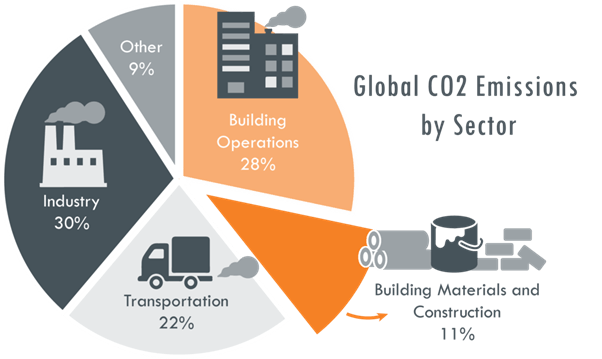
Operational carbon refers to the emissions that are produced to keep a building running. This includes running heat or air conditioning, powering lights and computers, and making sure water and waste are going to the right places. Typically, when we make decisions to reduce emissions in our schools or homes, to make them more sustainable, we focus on these operational emissions, such as using more energy efficient appliances or making renovations that reduce the need to run heat or air conditioning year-round. Fortunately, there are countless approaches we can take to reduce operational carbon in buildings, make them more efficient, and ensure they emit at little carbon as possible. Yet, while operational carbon accounts for a larger share of global emissions at 28% compared to embodied cardon at 11%, it is estimated that these will be the same by 2050.
So what is embodied carbon? This is the amount of carbon emitted during the construction of a building, including the raw materials, their manufacturing and refinement, transport from one location to the next, and the waste produced during construction. Walls, carpets, support beams, and everything that makes up a building is manufactured and produces emissions. The biggest challenge with embodied carbon is that once a building is up, those emissions cannot be reduced, even with the most energy efficient appliances. With Australia expecting the construction of hundreds of millions of new homes, apartments, and offices by 2050, it is essential that they are not only built to be energy efficient, but also built efficiently to reduce the amount of embodied carbon as much as possible.













